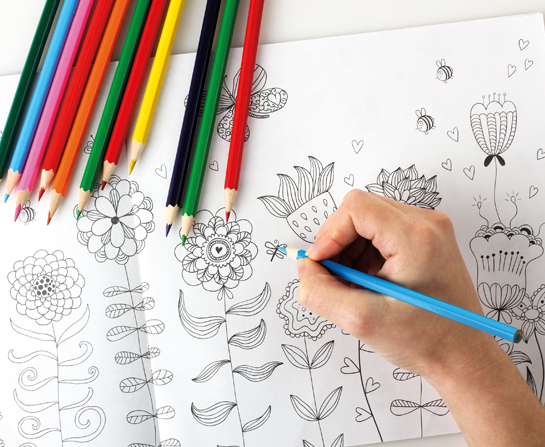Colour the Blues Away
May 3, 2022 Return

Just walk into any bookstore or newsstand, and you will see them displayed prominently. Colouring books for adults are simply everywhere and it seems like there is a new one released every month. They are all beautifully illustrated, and filling these intricate artworks with colours is said to be good for the mind.
A Colourful Mind
There may be some truth to claims that colouring books are good for the brain.
Our brain has a region called amygdala – not to be confused with Anakin Skywalker’s wife if you are a Star Wars fan – which processes our emotions. According to psychologist Gloria Martínez Ayala, the act of colouring involves parts of our brain that control our logic (“That’s a rose … so it will be red in colour!”) and creativity (“Let’s add some darker shading here and there …”), as well as our fine motor skills. Along the way, the activity of our amygdala decreases, which in turn allows us to relax and de-stress.
She adds that there are other benefits not related to the brain. The act of colouring, for example, may bring back happy childhood memories, which also helps us relax.
Dr Nikki Martinez, a health counselor, suggests that colouring books will benefit people whose mental issues are triggered by boredom, lack of structure or direction and stress. These people include those with obsessive-compulsive disorders, anxiety disorders, stress disorders, depressive disorders, eating and binge eating disorders, anger management issues, and substance abuse issues. Individuals with post-traumatic stress disorder may also benefit from the calming effects of colouring books.
A day for … colouring?
In the US, August 2 is National Colouring Book Day. Unsurprisingly, it was started by a publisher of some of the more popular adult colouring books out there. Nonetheless, this day has been adopted by organisations such as the National Center for Post-Traumatic Stress Disorder (PTSD) to champion the benefits of colouring books for people with mental issues.
An Incomplete Therapy?
Increasingly, colouring books are touted as a form of art therapy. This has several prominent art therapists stepping out to caution against buying the hype. Research psychologist and art therapist Dr Cathy Malchiodi is one of them. Art therapy, she points out, is more than simply colouring the pages of a book.
In art therapy, patients are encouraged to create works of art that they feel will best express their thoughts and feelings. The art therapist would use the creation process and the resulting artwork to help the patient resolve his or her issues, manage behaviour and feelings, reduce stress and improve self-esteem.
There is also enough evidence to demonstrate the benefits of using one’s hands to create something from imagination, which include not just stress and relaxation but also improved cognitive abilities, attention span, self awareness and sense of quality of life. Additionally, creating art with one’s hands also helps to reduce perception of pain and fatigue.
Therefore, individuals who need assistance that goes beyond coping with simple stress should seek social support and advice from a mental health professional. Colouring books are most likely inadequate to meet the emotional needs of these individuals.
The true colours?
Perhaps, in dissecting the hype behind adult colouring, we are missing the forest for the trees.
In April 2015, Neurology, a journal by American Academy of Neurology published a paper in their journal, published the findings of a study by the National Institute of Aging (US) on 256 mentally-sound individuals with a median age of 87. The findings are:
People who engaged in artistic activities in middle and old age are 73% less likely to have memory and thinking problems that could lead to dementia.
Craft-based activities (sewing, woodworking, or ceramics) can reduce likeliness of cognitive issues by 45%.
Socialising (e.g. going out to the movies with other people) can reduce the risk of developing mild cognitive impairment by 55%, while using a computer later in life reduces the risk by 53%.
The researchers concluded that people who have hobbies and/or active social life should try to maintain them for the rest of their lives.
Therefore, if you enjoy colouring, it probably does not matter whether the hype behind those adult colouring books is warranted or not. As long as you have a hobby you love, in the long run, your brain and your life will benefit from it. And if colouring books are not to your taste, there are so many other things you can do to chase the blues away and keep your brain in tip-top shape, so have fun finding one (or more) that you will enjoy!

References:
Psychology Today. Available at www.psychologytoday.com
Roberts, R.O., et al. (2015). Risk and protective factors for cognitive impairment in persons aged 85 years and older. Neurology. ;84(18):1854-61.
Science Daily. Available at www.sciencedaily.com
If you like this article, do subscribe here.
